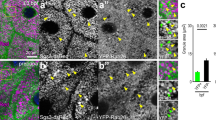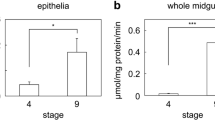Summary
The processes of involved in the accumulation and secretion of adhesive mucoprotein (“glue”) in third instar larvae ofD. melanogaster are described. The RNA templates for glue protein seem to be synthesized within 72–85 hours after oviposition, because treatment of larvae at this age with actinomycin D inhibits the accumulation of the secretion. The secretory granules appear in the salivary gland cells of 90 hour larvae and are discharged into the gland lumen of 118 hour larvae.
Secretion of mucoprotein material by salivary gland cells into the gland lumen depends on high ecdysone concentration. Mucoproteins are synthesized, but not discharged, by these cells in ecdysone-deficient homozygousl (2) gl larvae as well as in normal larvae isolated from ecdysone by ligatures or transplantation of the salivary glands into adult abdomens. Ecdysterone injection into normal 100 hour larvae, 7 dayl (2) gl larvae or into adult imaginal abdomens into which salivary glands have previously been stimulates mucoprotein secretion into the gland lumen.
Determination of total protein content in the salivary gland by Lowry's method has shown that “glue” proteins make up 21–32% of the total protein content in the gland.
The glands of thel (3) tl mutant do not give a PAS-positive reaction, nor are the granules of the secretion observed under the phase contrast microscope.
Similar content being viewed by others
References
Anderson, R., Hancock, M., Burdette, W. J.: A simple method for ligating and injectingDrosophila larvae. Dros. Inform. Serv.46, 198 (1966)
Ashburner, M.: Patterns of puffing activity in the salivary gland chromosomes ofDrosophila. I Autosomal puffing patterns in a laboratory stock ofDrosophila melanogaster. Chromosoma21, 398–428 (1967)
Ashburner, M.: Patterns of puffing activity in the salivary gland chromosomes ofDrosophila. V. Responses to environmental treatments. Chromosoma,31, 356–376 (1970a)
Ashburner, M.: Function and structure of polytene chromosomes during insect development. in: Adv. Insect. Physiol. London-New York7, 1–95 (1970b)
Ashburner, M.: Puffing patterns inDrosophila melanogaster and related species in: Results and Problems in Cell Differentiation (W. Beermann ed.)4, 101–151 (1972)
Becker, H. J.: Die Puffs der Speicheldrüsenchromosomen vonDrosophila. I. Mitt. Beobachtungen zum Verhalten des Puffmusters im Normalstamm und bei zwei Mutanten, giant und lethal-giant-larva. Chromosoma10, 654–678 (1959)
Becker, H. J.: Die Puffs der Speicheldrüsenchromosomen vonDrosophila melanogaster. Die Auslösung der Puffbildung, ihre Spezifität und ihre Beziehung zur Funktion der Ringdrüse. Chromosoma13, 341–384 (1962)
Been, A. C., Rasch, E. M.: Cellular and secretory proteins of the salivary glands ofSciara coprophila during the larval-pupal transformation. J. Cell. Biol.55, 420–432 (1972)
Belyaeva, E. S., Korochkina, L. S., Zhimulev, I. F., Nazarova, N. K.: Puff characteristics in the X-chromosome ofDrosophila melanogaster females. Tsitologia (USSR)16, 440–446 (1974)
Berendes, H. D.: Salivary gland function and chromosomal puffing patterns inDrosophila hydei Chromosoma17, 35–77 (1965)
Bianchi, A. G. de, Terra, W. R., Lara, F. J. S.: Formation of salivary secretion inRhynchosciara americana. I. Kinetics of labelled amino acid incorporation. J. Cell Biol.58, 470–476 (1973)
Clever, U.: Chromosome activity and cell function in polytenic cells. II. The formation of secretion in the salivary glands ofChironomus. Exp. Cell Res55, 317–322 (1969)
Doyle, D., Laufer, H.: Sbources of larval salivary gland secretion in the dipteranChironomus tentans. J. Cell Biol.40, 61–78 (1969).
Ephrussi, B., Beadle, G. B.: A technique of transplantation forDrosophila. Amer. Naturalist70, 218–225 (1936)
Fraenkel, G.: A function of the salivary glands of the larvae ofDrosophila and other flies. Biol. Bull.103, 285 (1952)
Fraenkel, G., Brookes, V. J.: The process by which the puparia of many species of flies become fixed to a substrate. Biol. Bull.105, 442–449 (1953)
Gaudecker, B. von: Der Strukturwandel der larvalen Speicheldrüse vonDrosophila melanogaster. Ein Beitrag zur Frage nach der steuernden Wirkung aktiver Gene auf das Cytoplasma. Z. Zellforsch.127, 50–86 (1972)
Hadorn, E.: An accelerating effect of normal “ring-glands” on puparium formation in lethal larvae ofDrosophila melanogaster. Proc. Nat. Acad. Sci.23, 478–484 (1937)
Kilby, B. A.: The biochemistry of insect fat body. In: Advances in Insect Physiology. Academic Press, London-New York 1 112–174 (1963)
Kodani, M.: The protein of the salivary gland secretion inDrosophila. Proc. Nat. Acad. Sci. USA34, 131–135 (1948)
Kobel, H. R., Breugel, F. M. A., van: Observation on ltl (lethal tumorous larvae) ofDrosophila melanogaster. Genetica38, 305–327 (1968)
Korochkina, L. S.: Change of the ring gland in post-natal development ofDrosophila melanogaster Canton-S and in l(2)gl mutant. Dros. Inform. Serv.48, 74–75 (1972)
Lane, N. J., Carter, J. R., Ashburner, M.: Puffs and salivary gland function: the fine structure of the larval and prepupal salivary glands ofDrosophila melanogaster. Wilhelm Roux' Archiv,169, 216–238 (1972)
Laufer, H.: Chromosomal puffing and its relation to cell function and development. Arch. d'Anat. microscop.54, 648–651 (1965)
Layne, E.: Spectrophotometric and turbidimetric methods for measuring proteins. in: Methods in Enzymology3, 447–500 New York: Academic Press 1957
Martin, M. D., Kinnear, J. F., Thomson, J. A.: Developmental changes in the late larva ofCalliphora stygia. IV. Uptake of plasma protein by fat body. Austr. J. Biol. Sci.24, 291–299 (1971)
Novak, V. J. A.: Insect Hormones. London: Methuen and Co LTD 1966
Pelled, Y., Tietz, A.: Fat transport in the locustLocusta migratoria: the role of protein synthesis. Biochim. et biophys. Acta296, 499–509 (1973)
Perkowska, E.: Characteristics ofDrosophila salivary gland secretion. Exp. Cell Res.32, 259–271 (1963)
Poels, C. L. M.: Time sequence in the expression of various developmental characters induced by ecdysterone inDrosophila hydei. Develop. Biol.23, 210–225 (1970)
Poels, C. L. M.: Mucopolysaccharide secretion fromDrosophila salivary gland cells as a consequence of hormone induced gene activity. Cell Differ1, 63–78 (1972)
Poels, C. L. M., Loof, A. de, Berendes, H. D.: Functional and structural changes inDrosophila salivary gland cells triggered by ecdysterone. J. Insect Physiol.17, 1717–1729 (1971)
Rizki, T. M.: Ultrastructure of the secretory inclusion of the salivary gland cell inDrosophila. J. Cell Biol.32, 531–534 (1967)
Wobus, U., Popp, S., Serfling, E., Panitz, R.: Protein synthesis in salivary gland. Mol. Gen. Genet.116, 309–321 (1972)
Wyss-Huber, M., Lüscher, M.: In vitro synthesis and release of proteins by fat body and ovarian tissue ofleucophaea maderae during the sexual cycle. J. Insect Physiol.18, 689–710 (1972)
Scharrer, B., Hadorn, E.: The structure of the ring gland (corpus allatum) in normal and lethal larvae ofDrosophila melanogaster. Proc. Nat. Acad. Sci. USA24, 236–242 (1938)
Zhimulev, I. F.: Description of a new type of secrete in the larval salivary gland ofDrosophila melanogaster. Dros. Inform. Serv.,50, 46 (1973a)
Zhimulev, I. F.: Comparison of puffing patterns in proximal and distal parts of the salivary gland inDrosophila melanogaster. Dros. Inform. Serv.50, 96–97 (1973b)
Zhimulev, I. F.: Comparative study of the function of polytene chromosomes in laboratory stocks ofDrosophila melanogaster and the l(3) tl mutant (lethal tumorous larvae). I. Analysis of puffing patterns in autosomes of the laboratory stock Batumi-L. Chromosoma46, 59–76 (1974)
Zhimulev, I. F., Belyaeva, E. S.:3H-uridine labelling patterns inDrosophila melanogaster salivary gland chromosomes, X, 2R, and 3L. Chromosoma49, 219–231 (1975)
Zhimulev, I. F., Belyaeva, E. S., Lychev, A. V.: Changes of banding patterns in the polytene chromosomes of l(3)tl mutant ofDrosophila melanogaster. Genetica (USSR)10, N 10, 35–50 (1974)
Author information
Authors and Affiliations
Rights and permissions
About this article
Cite this article
Zhimulev, I.F., Kolesnikov, N.N. Synthesis and secretion of mucoprotein glue in the salivary gland ofDrosophila melanogaster . Wilhelm Roux' Archiv 178, 15–28 (1975). https://doi.org/10.1007/BF00848359
Received:
Issue Date:
DOI: https://doi.org/10.1007/BF00848359




